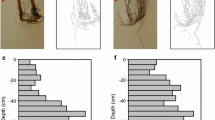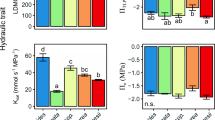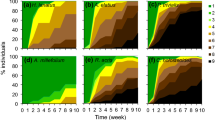Abstract
The grass layer of African savannas consists of two main vegetation types: grazing lawns, dominated by short, mostly clonally reproducing grasses, and bunch grasslands, dominated by tall bunch grasses. This patchy distribution of vegetation types is mostly created by large herbivores, which selectively feed on the more nutritious lawn grass species. Besides grazing, herbivores trample the soil, thereby causing soil compaction, with possible consequences for water infiltration. This raises two questions: (i) is water more limiting in grazing lawns than in bunch grasslands and (ii) are lawn grasses more drought tolerant than bunch grasses? To study these questions, we compared drought conditions in both lawn and bunch grasslands in a South African savanna. Additionally, in a climate room, we compared the performance of three lawn and three bunch grass species under a control and a water limitation treatment. Thirdly, we investigated whether there are differences between lawn and bunch grasses in traits related to drought tolerance. Our results show that despite large differences in water availability in the field, lawn and bunch grasses did not differ in their growth response to drought. Drought reduced growth of both growth forms equally. However, we found strong intrinsic trait differences between growth forms, with lawn grasses having higher specific root length and relative growth rate and bunch grasses having a higher root:shoot ratio. These results suggest that after drought-induced plant death, lawn grasses might be more capable of recolonizing patches of bare soil.






Similar content being viewed by others

References
Abdel-Magid AH, Schuman GE, Hart RH (1987) Soil bulk density and water infiltration as affected by grazing systems. J Range Manag 40:307–309
Anderson TM, Dong Y, McNaughton SJ (2006) Nutrient acquisition and physiological responses of dominant Serengeti grasses to variation in soil texture and grazing. J Ecol 94:1164–1175
Anderson TM, Kumordzi BB, Fokkema W, Valls Fox H, Olff H (2013) Distinct physiological responses underlie defoliation tolerance in African lawn and bunch grasses. Int J Plant Sci 174:769–778
Archibald S, Bond WJ, Stock WD, Fairbanks DHK (2005) Shaping the landscape: fire-grazer interactions in an African savanna. Ecol Appl 15:96–109
Asseng S, Ritchie JT, Smucker AJM, Robertson MJ (1998) Root growth and water uptake during water deficit and recovering in wheat. Plant Soil 201:265–273
Belsky AJ (1986) Population and community processes in a mosaic grassland in the Serengeti, Tanzania. J Ecol 74:841–856
Bonnet O, Fritz H, Gignoux J, Meuret M (2010) Challenges of foraging on a high-quality but unpredictable food source: the dynamics of grass production and consumption in savanna grazing lawns. J Ecol 98:908–916
Bouchenak-Khelladi Y, Verboom GA, Hodkinson TR et al (2009) The origins and diversification of C-4 grasses and savanna-adapted ungulates. Glob Change Biol 15:2397–2417
Bower H (1986) Intake rate: cylinder infiltrometer. In: Klute A (ed) Methods of soil analysis. American Society of Agronomy and Soil Science Society of America, Madison, pp 825–843
Chai Q, Jin F, Merewitz E, Huang BR (2010) Growth and physiological traits associated with drought survival and post-drought recovery in perennial turfgrass species. J Am Soc Hortic Sci 135:125–133
Cromsigt JPGM, Olff H (2008) Dynamics of grazing lawn formation: an experimental test of the role of scale-dependent processes. Oikos 117:1444–1452
Cumming DHM, Cumming GS (2003) Ungulate community structure and ecological processes: body size, hoof area and trampling in African savannahs. Oecologia 134:560–568
Downing BH (1980) Relationships between rock substrate, landform and soil in Unfolozi game reserve, as explained for conservation purposes. Lammergeyer 30:32–48
Dunne T, Western D, Dietrich WE (2011) Effects of cattle trampling on vegetation, infiltration, and erosion in a tropical rangeland. J Arid Environ 75:58–69
Eissenstat DM, Yanai RD (2002) Root life span, efficiency, and turnover. In: Waisel Y, Eshel A, Kafkafi U (eds) Plant roots the hidden half, 3rd edn edn. Marcel Dekker, Inc, New York, pp 339–366
Hagenah N, Prins HHT, Olff H (2009) Effects of large herbivores on murid rodents in a South African savannah. J Trop Ecol 25:483–492
Huang B (1999) Water relations and root activities of Buchloe dactyloides and Zoysia japonica in response to localized soil drying. Plant Soil 208:179–186
Huang B, Eissenstat DM (2000) Linking hydraulic conductivity to anatomy in plants that vary in Specific Root Length. J Am Hortic Sci 125:260–264
King L (1970) The geology of the Hluhluwe Game Reserve. Petros 2:16–19
Kleynhans EJ, Jolles AE, Bos MRE, Olff H (2011) Resource partitioning along multiple niche dimensions in differently sized African savanna grazers. Oikos 120:591–600
McNaughton SJ (1984) Grazing lawns: animals in herds, plant form, and coevolution. Am Nat 124:863–886
McNaughton SJ (1985) Ecology of a grazing ecosystem—the Serengeti. Ecol Monogr 55:259–294
McNaughton SJ (1992) Laboratory-simulated grazing: interactive effects of defoliation and canopy closure on Serengeti grasses. Ecology 73:170–182
Metzger KL, Coughenour MB, Reich RM, Boone RB (2005) Effects of seasonal grazing on plant species diversity and vegetation structure in a semi-arid ecosystem. J Arid Environ 61:147–160
Pinheiro J, Bates D (2000) Mixed-effecs Models in S and S-PLUS. Springer-Verlag, New York, USA
R Development Core Team (2011) R: a language and environment for statistical computing. R Foundation for Statistical Computing, Vienna
Reich PB, Tjoelker MG, Walters MB et al (1998) Close association of RGR, leaf and root morphology, seed mass and shade tolerance in seedlings of nine boreal tree species grown in high and low light. Funct Ecol 12:327–338
Ripley B, Frole K, Gilbert M (2010) Differences in drought sensitivities and photosynthetic limitations between co-occurring C3 and C4 (NAPD-ME) Panicoid grasses. Ann Bot 105:493–503
Scholes RJ, Walker BH (1993) An African savanna: synthesis of the Nylsvley study, 1st edn. Cambridge University Press, Cambridge
Schulze ED, Mooney HA, Sala OE et al (1996) Rooting depth, water availability, and vegetation cover along an aridity gradient in Patagonia. Oecologia 108:503–511
Stock WD, Bond WJ, van de Vijver CADM (2010) Herbivore and nutrient control of lawn and bunch grass distributions in a Southern African savanna. Plant Ecol 206:15–27
Van der Plas F, Anderson TM, Olff H (2012) Trait similarity patterns within grass and grasshopper communities: multitrophic community assembly at work. Ecology 93:836–846
Whateley A, Porter RN (1983) The woody vegetation communities of the Hluhluwe-Corridor-Umfolozi game reserve complex. Bothalia 14:745–758
Acknowledgments
We thank Jacob Hogendorf, Ger Telkamp, Carmen van de Beld and Saria Babikir for providing help with conducting the experiments, Jan Henk Venema for advice on measurements, Adriana Alzate Vallejo for helping with the survival analysis and Wimke Fokkema for feedback on an earlier version of this manuscript.
Author information
Authors and Affiliations
Corresponding author
Electronic supplementary material
Below is the link to the electronic supplementary material.
Rights and permissions
About this article
Cite this article
van der Plas, F., Zeinstra, P., Veldhuis, M. et al. Responses of savanna lawn and bunch grasses to water limitation. Plant Ecol 214, 1157–1168 (2013). https://doi.org/10.1007/s11258-013-0240-8
Received:
Accepted:
Published:
Issue Date:
DOI: https://doi.org/10.1007/s11258-013-0240-8



